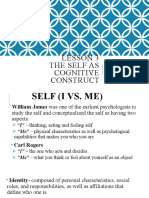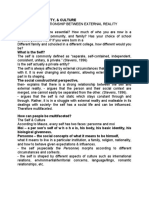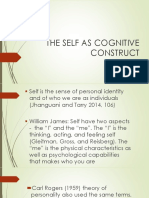0 ratings0% found this document useful (0 votes)
33 viewsUts
Lesson 2: Self as the cognitive construct
Uploaded by
Roldan Serrano BelloCopyright
© © All Rights Reserved
Available Formats
Download as DOCX, PDF, TXT or read online on Scribd
0 ratings0% found this document useful (0 votes)
33 viewsUts
Lesson 2: Self as the cognitive construct
Uploaded by
Roldan Serrano BelloCopyright
© © All Rights Reserved
Available Formats
Download as DOCX, PDF, TXT or read online on Scribd
You are on page 1/ 5
Understanding the self - lecture 3 HAND-OUT
1. LECTURE 3: THE SELF as a COGNITIVE CONSTRUCT THIS LESSON
PROVIDES AN OVERVIEW OF THE THEMESOF PSYCHOLOGY REGARDING
THECONCEPT OF “SELF”.
Cognitive psychology - concerned with mental processes(as
perception, thinking, learning, and memory) especially with
respect to the internal events occurring between sensing and the
expression of behavior.
Cognition - the mental processes involved in gaining knowledge &
comprehension. Itincludes thinking, knowing, remembering,
judging and problem-solving.
These are higher-level functions of the brain and encompass
language, imagination, perception, and planning.
In psychology, the self is defined as: “the sense of personal
identity and of who we are as individuals.”
William James(1890) conceptualized the self as:
“I” – the thinking ,acting, and feelingself.
“Me” – the physical characteristics; capabilities.
In Carl Rogers’(1959) theory of personality:
“I” – the one who acts and decides
“Me” – what you think or feel about yourself
Another conceptof the self is IDENTITY/SELF-CONCEPT:
Identity –composed of personal characteristics, social roles,
responsibilities.
Self-concept – it is what comes to your mind when asked about
who you are.
– it is not fixed in one time frame Rogers captured this idea in
his concept of SELF-SCHEMA, our organized system or collection
of knowledge about who we are.
The self-schema includes your hobbies, family, religion,
nationality, interests, work, course, age name, etc, As you grow
and adapt to the changes around you, they also change.
They actively shape and affect how you see, think, and feel
about things.
Psychological theories see the self and identity as mental
constructs, created and recreated in memory.
Current researches point to the frontal lobe of the brain as the
area associated with processes concerning the self.
One Influential psychologist of our generation is Sigmund Freud,
he sees the self and the mind as a result of interaction between
these 3 parts:
Id - the instinctual part of the mind that contains sexual and
aggressive drive sand hidden memories. It is selfish and wishful
in nature. Illogical and fantasy oriented.
Ego - the realistic part that mediates between the desires of
the id and the super-ego. Modified by the direct influence of
the external world. The decision-making component of
personality.
Superego - operates as a moral conscience. Applies the values of
society which are learned from one's parents and others.
The theory of symbolic interactionism (G.H.Mead) argues that the
self is created & developed through human interaction.
We are social products because:
1. We do not create ourselves out of nothing.
2. We need others to affirm and reinforce who we think we are.
3. What’s important to us is influenced by our social/historical
context. When we are aware of our self-concepts, that is called
SELF- AWARENESS.
The 2 types of self we can be aware of are:
1. The private self – your internal private thought sand
feelings
2. The public self/image –geared to having a good presentation
of yourself to others. - Carver & Scheier (1981)
Self-awareness presents us three other self- schema:
1. Actual self – who you are at the moment
2. Ideal self – who you like to be
3.Ought self – who you think you should be(responsibilities,
etc)
Self-awareness may be positive or negative. At other times, we
may experience“ loss of individual self- awareness and
accountability in groups.
A lot of people at tune themselves with the emotions of their
group.
Being in a large crowd may lessen our self-control.
Social relationships affect or self-esteem through social
comparison. In this theory, we learn about ourselves, the
appropriateness of our behaviors, as well as our status, by
comparing ourselves to other people.
Downward social comparison –is a common type of comparing
ourselves to others. We create a POSITIVE self-concept by
comparing ourselves with those who are WORSE than us.
Upward social comparison –is comparing ourselves with those who
are better than us. It can be MOTIVATION for some, but it could
also LOWERYOURSELF-ESTEEM because it shows your weaknesses.
These also occur not only in individuals but also in groups.
Social comparison is connected to the self-evaluation
maintenance theory, which states that we feel THREATENED when
someone out-performs us, or does better than us. Especially when
that person is a close peer/ partner/ friend.
We usually act in 3 ways in these situations:
1. we distance ourselves from the person.
2. we reconsider the aspect or skill you were out performed in.
3. we try to improve that aspect of ourselves. But then,
sometimes to increase or maintain self-esteem, some may become
NARCISSISTIC.
Meaning: overly high self-esteem, self- admiration, self-
centeredness. There is a difference between self-esteem and
narcissism People with high self-esteem are usually outgoing,
adventurous, adaptable in a lot of situations. But they could
also be bullies and experiment on abusive behavior, drugs,
alcohol, etc
You might also like
- The Self As Cognitive Construct: Prepared By: Ms. Justine Jane B. Ceriales, RPM100% (3)The Self As Cognitive Construct: Prepared By: Ms. Justine Jane B. Ceriales, RPM22 pages
- Chapter 1 - Lesson 3 - The Self As Cognitive ConstructNo ratings yetChapter 1 - Lesson 3 - The Self As Cognitive Construct3 pages
- Chapter 1 Lesson 3 The Self As Cognitive ConstructNo ratings yetChapter 1 Lesson 3 The Self As Cognitive Construct3 pages
- Chapter 1 - Lesson 3 - The Self as Cognitive Construct.docxNo ratings yetChapter 1 - Lesson 3 - The Self as Cognitive Construct.docx3 pages
- 3 LESSON-3-The-Self-as-a-Cognitive-ConstructNo ratings yet3 LESSON-3-The-Self-as-a-Cognitive-Construct3 pages
- UTS-Lesson 3the Self As Cognitive ConstructNo ratings yetUTS-Lesson 3the Self As Cognitive Construct18 pages
- The Self As A Cognitive Construct: Prepared By: Minera Laiza C. Acosta, MP, RPM100% (1)The Self As A Cognitive Construct: Prepared By: Minera Laiza C. Acosta, MP, RPM17 pages
- Lesson 3 The Self As Cognitive Construct: Ms. Bianca NuestroNo ratings yetLesson 3 The Self As Cognitive Construct: Ms. Bianca Nuestro10 pages
- Chapter 1 Lesson 3 The Self As A Cognitive ConstructNo ratings yetChapter 1 Lesson 3 The Self As A Cognitive Construct24 pages
- Understanding The Self PPT 231008150949 04a2094bNo ratings yetUnderstanding The Self PPT 231008150949 04a2094b16 pages
- LESSON 3 - The Self As Cognitive ConstructNo ratings yetLESSON 3 - The Self As Cognitive Construct4 pages
- Lesson-3: The Self As A Cognitive Construct: Reporters: Lera F. Faina Jonard Tan Del Campo Gina Mae E. MaganggoNo ratings yetLesson-3: The Self As A Cognitive Construct: Reporters: Lera F. Faina Jonard Tan Del Campo Gina Mae E. Maganggo25 pages
- GNED 08-Lesson 3-The Self As Cognitive Construct100% (1)GNED 08-Lesson 3-The Self As Cognitive Construct39 pages
- Psychological Persperctive of The Self PDFNo ratings yetPsychological Persperctive of The Self PDF5 pages
- Chapter 1 Lesson 3 The Self As Cognitive ConstructNo ratings yetChapter 1 Lesson 3 The Self As Cognitive Construct20 pages
- Module 4 - Psychological Perspectives of The SelfNo ratings yetModule 4 - Psychological Perspectives of The Self7 pages
- Personal Self-Concept and Satisfaction With Life in Adolescence, Youth and AdulthoodNo ratings yetPersonal Self-Concept and Satisfaction With Life in Adolescence, Youth and Adulthood7 pages
- PR2 LAS - Quarter 1 - Week 4 - October 4 - 8 2021No ratings yetPR2 LAS - Quarter 1 - Week 4 - October 4 - 8 20214 pages
- Aristophanes: Clouds, Women at The Thesmophoria, Frogs: A Verse Translation, With Introduction and Notes 1st Edition Stephen Halliwell100% (5)Aristophanes: Clouds, Women at The Thesmophoria, Frogs: A Verse Translation, With Introduction and Notes 1st Edition Stephen Halliwell62 pages
- AC500 High Availability Library For CM574-RSNo ratings yetAC500 High Availability Library For CM574-RS2 pages
- Jurnal Pengaruh Pemberian MPASI Fortifikasi Vs HomemadeNo ratings yetJurnal Pengaruh Pemberian MPASI Fortifikasi Vs Homemade5 pages
- NCERT Solutions For Class 12th Microeconomics - Chapter 3 - Production and Costs - AglaSem SchoolsNo ratings yetNCERT Solutions For Class 12th Microeconomics - Chapter 3 - Production and Costs - AglaSem Schools12 pages
- Human Resource Management Assignment Case Study - Job Analysis at Go-ForwardNo ratings yetHuman Resource Management Assignment Case Study - Job Analysis at Go-Forward11 pages
- Elsa Online. ElsaWin. ElsaWeb. VW1.6 L - 75 KW - Simos, Engine Code ALZ, From October 2000No ratings yetElsa Online. ElsaWin. ElsaWeb. VW1.6 L - 75 KW - Simos, Engine Code ALZ, From October 20001 page
- ASEU TEACHERFILE WEB 5831243475081930867.docx 1618394686No ratings yetASEU TEACHERFILE WEB 5831243475081930867.docx 16183946867 pages
- The Self As Cognitive Construct: Prepared By: Ms. Justine Jane B. Ceriales, RPMThe Self As Cognitive Construct: Prepared By: Ms. Justine Jane B. Ceriales, RPM
- Chapter 1 - Lesson 3 - The Self As Cognitive ConstructChapter 1 - Lesson 3 - The Self As Cognitive Construct
- Chapter 1 Lesson 3 The Self As Cognitive ConstructChapter 1 Lesson 3 The Self As Cognitive Construct
- Chapter 1 - Lesson 3 - The Self as Cognitive Construct.docxChapter 1 - Lesson 3 - The Self as Cognitive Construct.docx
- The Self As A Cognitive Construct: Prepared By: Minera Laiza C. Acosta, MP, RPMThe Self As A Cognitive Construct: Prepared By: Minera Laiza C. Acosta, MP, RPM
- Lesson 3 The Self As Cognitive Construct: Ms. Bianca NuestroLesson 3 The Self As Cognitive Construct: Ms. Bianca Nuestro
- Chapter 1 Lesson 3 The Self As A Cognitive ConstructChapter 1 Lesson 3 The Self As A Cognitive Construct
- Lesson-3: The Self As A Cognitive Construct: Reporters: Lera F. Faina Jonard Tan Del Campo Gina Mae E. MaganggoLesson-3: The Self As A Cognitive Construct: Reporters: Lera F. Faina Jonard Tan Del Campo Gina Mae E. Maganggo
- Chapter 1 Lesson 3 The Self As Cognitive ConstructChapter 1 Lesson 3 The Self As Cognitive Construct
- Personal Self-Concept and Satisfaction With Life in Adolescence, Youth and AdulthoodPersonal Self-Concept and Satisfaction With Life in Adolescence, Youth and Adulthood
- Aristophanes: Clouds, Women at The Thesmophoria, Frogs: A Verse Translation, With Introduction and Notes 1st Edition Stephen HalliwellAristophanes: Clouds, Women at The Thesmophoria, Frogs: A Verse Translation, With Introduction and Notes 1st Edition Stephen Halliwell
- Jurnal Pengaruh Pemberian MPASI Fortifikasi Vs HomemadeJurnal Pengaruh Pemberian MPASI Fortifikasi Vs Homemade
- NCERT Solutions For Class 12th Microeconomics - Chapter 3 - Production and Costs - AglaSem SchoolsNCERT Solutions For Class 12th Microeconomics - Chapter 3 - Production and Costs - AglaSem Schools
- Human Resource Management Assignment Case Study - Job Analysis at Go-ForwardHuman Resource Management Assignment Case Study - Job Analysis at Go-Forward
- Elsa Online. ElsaWin. ElsaWeb. VW1.6 L - 75 KW - Simos, Engine Code ALZ, From October 2000Elsa Online. ElsaWin. ElsaWeb. VW1.6 L - 75 KW - Simos, Engine Code ALZ, From October 2000
- ASEU TEACHERFILE WEB 5831243475081930867.docx 1618394686ASEU TEACHERFILE WEB 5831243475081930867.docx 1618394686

























































































